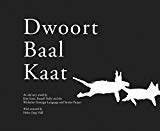
Title
Dwoort Baal Kaat
Author
Kim Scott
Secondary Authors
Russell Nelly, Wirlomin Noongar Language and Stories Project
Illustrators
Helen (Ing) Hall
Publisher, Date
University of Western Australia Press, 2013
Audience
5-8yrs, Lower Primary, Primary
ISBN
9781742585116
Language
English, Noongar / Nyungar / Nyungah languages (W41) (WA SI50)
Add to Favourites
-
Subjects
- Bilingual books
- Dogs
- Fire
- Glossaries and vocabularies
- Hunting and gathering
- Noongar/ Nyungar / Nyungah people (WA41 (WA SI50)
- Oceans
- Rocks
- Seals
-
Annotation
A Noongar man is hunting with his dogs – but everything the dogs catch and kill, they eat before he can catch up to them. They don’t leave him anything so that ‘he was so hungry, his belly was bashing his backbone’. He lights a fire around the greedy dogs, which they escape by running through it into the ocean. When they swim out of the water, they are transformed into seals.
Each double page spread has text on the left and a full colour painting on the right. These simple acrylic paintings evoke the colours of the land and seascape of the southwest of Western Australia. The seals become rocks which is a dramatic pictorial end to the story.
The text is in both Noongar language with two translations into English. The Noongar appears first, with literal English translation of each word or phrase underneath. This enables the reader of only English to feel the grammar and style of the original oral story eg ‘Dwoort baal kaat’ literally means ‘Dog His Head’. The story as picture book text (to be read aloud in English) appears at the bottom of the page.
The American linguist Gerhardt Laves recorded stories told to him by Noongar men Bob Roberts and Freddie Winmer at Albany Western Australia in 1931. Laves’ family returned the stories with his papers to WA 50 years later. The Roberts and Winmer families, along with other community members, extensively workshopped the stories as part of the Noongar Language and Stories Project over several years, resulting in six published picture books.
An essay at the back of the book has more detail about the development of the stories into published form, including workshopping in local schools. Readings of the book in both Noongar and English are available through the project’s website.
A glossary is provided with this note: ‘We rely on the spelling conventions of the now defunct Noongar Language and Cultural Centre and Education Department of WAS although dialect differences may make some of our choices unorthodox.’
-
Teaching Resources
- Wirlomin Noongar Language and Stories Project, Books (Listen in Noongar and English) https://www.wirlomin.com.au/stories/books/
- Australian Broadcasting Corporation, Mamang and Noongar Mambara Bakitj : Noongar stories keeping heritage strong https://www.abc.net.au/local/stories/2011/10/13/3338688.htm
- Curtin University, Bringing the stories home: Wirlomin Noongar Language and Stories Project https://research.curtin.edu.au/story/bringing-stories-home-wirlomin-noongar-language-stories-project/
- Australian Geographic, The 6 seals and sea lions that (sometimes) call Australia home https://www.australiangeographic.com.au/topics/wildlife/2018/04/the-6-seals-and-sea-lions-that-sometimes-call-australia-home/
- Reading Australia profile of Kim Scott https://readingaustralia.com.au/authors/kim-scott/
- The Conversation, ‘How children’s picturebooks can disrupt existing language hierarchies’ by Nicola Daly, 31 May 2018 https://theconversation.com/how-childrens-picturebooks-can-disrupt-existing-language-hierarchies-96275
